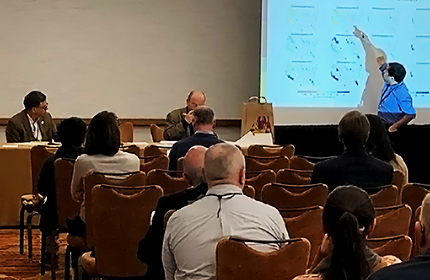Breakout Session: Busting Food Sustainability Myths – Climate Adaptation & Mitigation Opportunities in Fruit & Vegetable Supply Chains
-

November 21, 2019
11:30 am - 12:30 amSustainable Agriculture Summit
Indianapolis, Indiana, USA
Speakers

Dr. Dave Gustafson
Agriculture & Food Systems Institute
Dr. Kaiyu Guan
University of Illinois
Dr. Greg Thoma
University of ArkansasOverview
The vast majority of Americans now live their lives almost entirely detached from agriculture and the realities of food production, rendering them increasingly susceptible to urban folklore and myths about so-called “sustainable food.” Fruits and vegetables are an important class of foods for which an entire mythology around sustainability has developed. Organized by the Fruit and Vegetable Supply Chains: Climate Adaptation and Mitigation Opportunities project, this breakout session at the Sustainable Agriculture Summit addressed many of those myths through a creative presentation of the findings generated by a highly interdisciplinary research team, which is now two years into a four-year effort.
More information about the Sustainable Agriculture Summit
Descriptions
Americans are encouraged to eat more fruit and vegetables as part of a balanced diet, and they have come to accept as true many tenuous precepts about the sustainability of fruit and vegetable food systems (e.g., local means more sustainable, water use is high and getting worse, organic is healthier, etc.). Another assertion often heard is that both climate change and decreased availability of irrigation water will make it increasingly difficult to meet future fruit and vegetable demand. However, industry stakeholders report that relatively minor management practice changes have so far been sufficient to adapt to these challenges. These same stakeholders report that the significant innovation and transformation of fruit and vegetable supply chains now underway is actually dominated by primarily socioeconomic considerations: consumer preference for fresh produce grown locally, increased competition for natural resources, cost and availability of labor, efforts to improve sustainability profiles, and the rise of protected and peri-urban production.
But what about the future?
Our highly interdisciplinary research team is now two years into a first-ever four-year, USDA NIFA-funded effort to explore climate adaptation and mitigation opportunities in U.S. fruit and vegetable supply chains, through the application of a novel integrated modeling framework that includes crop, economic, and Life Cycle Assessment (LCA) models. During this breakout session at the Sustainable Agriculture Summit, we employed a creative approach, in which we first presented and then “busted” a series of “myths” about the sustainability of fruit and vegetable supply chains.
Learning Objectives
- Upon completion, participants were able to articulate and utilize accurate information concerning the factors (primarily socioeconomic in nature) that are most responsible for ongoing changes in fruit and vegetable supply chains.
- Upon completion, participants were able to respond in a fully-informed manner to how continuing changes in climate patterns and irrigation water availability are expected to impact fruit and vegetable supply chains.
- Upon completion, participants were able to pursue opportunities for expansion of domestic fruit and vegetable production in areas with high yields and favorable sustainability profiles.
- Upon completion, participants were able to address the fruit and vegetable supply chain steps having the largest impact on overall environmental footprints (land, water, and GHGs).
